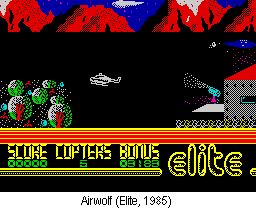|

By Lloyd Mangram
February
1985
Issue 13
|
|
Generally
known as 'The Spectrum Kid', this cover used colour
more ambitiously than any of its predecessors. Oliver
was keen on painting an almost abstract subject, the
wondrous thrill of a newcomer to the Spectrum (there
were always many more after Christmas), wide open to
its magic and mystery. It's a simple piece of symbolism,
the Spectrum colours animating the otherwise grey, ethereal
figure - yet the delicacy of the painting seems to illuminate
the whole cover so that it adds up to more than the
sum of the parts; there's really nothing here tied to
any game.
|
Even game maps had become the subject of exclusivity! Witness
the cover flash for Psytraxx from The Edge. Exclusive
maps were, and still are, a rather daft notion. But by this
point magazines would slap 'exclusive' over anything that
could be drawn within hours of a preview copy's arrival to
beat a rival magazine's carefully negotiated 'official' map.
 The
good turn Elite unwittingly did CRASH, which I mentioned earlier
in the CRASH History, was concerned with its game Airwolf.
This was to be a TV tie-in in reverse. Elite sent the Birmingham-based
Central TV news desk a press release about the youthfulness
of Airwolf's programmer (actually Richard Wilcox, young,
but not quite the spring chicken the release made him out
to be!). Central rang Roger Kean to double-check whether this
was commonplace, and whether Airwolf actually was a
hit game. Roger told the researcher that he would have to
consult his school-age reviewing team, a statement calculated
to arouse Central's interest. The
good turn Elite unwittingly did CRASH, which I mentioned earlier
in the CRASH History, was concerned with its game Airwolf.
This was to be a TV tie-in in reverse. Elite sent the Birmingham-based
Central TV news desk a press release about the youthfulness
of Airwolf's programmer (actually Richard Wilcox, young,
but not quite the spring chicken the release made him out
to be!). Central rang Roger Kean to double-check whether this
was commonplace, and whether Airwolf actually was a
hit game. Roger told the researcher that he would have to
consult his school-age reviewing team, a statement calculated
to arouse Central's interest.
The thought that a bunch of mere schoolkids was passing judgement
on games which would then affect large companies' sales -
and all this from the obscure town of Ludlow - was irresistible.
Next day, a four-man Central TV crew arrived in Ludlow to
interview Matthew Uffindell, Ben Stone, Robin Candy and Roger
Kean. The TV reporters wanted to have the CRASH reviewers
playing Airwolf and chatting about it. Unfortunately
it was left to Robin to say why he thought it was a hit, and
because he was the only person on the team who really didn't
like the game much he was largely cut out from the edited
programme, as was Airwolf. But CRASH appeared the following
evening, December 19, on Central News in a five-minute piece.
Also that month Legend gave us The Great Space Race,
leaving most reviewers undecided as to whether it was the
biggest disappointment of all time or the biggest hoax. Large
shipments hit the shelves before the reviews - and then the
sales died. Sometimes, justice does prevail.
All magazine publishers were concerned that the Government
would levy 15% VAT on magazines in the April Budget. Periodicals
and books had always been zero-rated, and there were gloomy
prognostications that such a tax would mean most magazines
would have to increase their cover price to stay afloat financially,
and thus lose readers. All this led Roger to predict in his
editorial the death of some computer titles.
In the event magazines were left alone by VAT, but several
titles would still close, as the computer-magazine market,
safely sailing for three years, entered a period of great
change in the wake of CRASH’s quirky success.
An early software casualty of 1985 was Fantasy, whose Backpacker's
Guide To The Universe had failed to hit the mark. Fantasy
released Drive In, a reasonably-rated yet nevertheless
disappointingly derivative game, and then, as everyone awaited
news of the sequel to Backpacker's, simply vanished
from the face of Cheltenham, leaving debts and confusion.
On the brighter side, Hewson scored a Smash with Technician
Ted, a surprise to many outsiders, who considered the
game nothing more than a competent Jet Set Willy clone.
The CRASH team just loved it, though. Of course there was
also Airwolf (Candy excepted) and Firebird's first
full-price (Gold Range) game, Buggy Blast - a 3-D shoot-'em-up
bettered since, but impressive then.
Derek had some thrills too: Doomdark's Revenge proved
to be even better than its predecessor, Lords Of Midnight,
making programmer Mike Singleton one of the most praised people
in the business.
And I shouldn't avoid recalling that, to our shame, this
issue also reviewed Jon Ritman's Match Day, failing
to Smash it - we've never been allowed to forget that! And
Robin Candy's never forgotten Issue 13 either, for this was
his first as Playing Tipster, complete with cute little curly-haired
photograph. He loved the fame, hated the photo and it has
dogged him since - serves him right too.
|